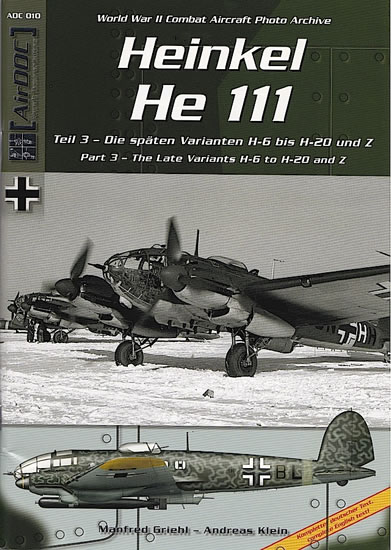AirDOC Publications
Heinkel He 111 Part 3
by Manfred Griehl and Andreas Klein

| F i r s t L o o k |
Publisher, Title and ISBN: |
AirDOC
Heinkel He 111 Part 3 – the Late Variants H-6 to H-20 and Z
978-3-935687-49-2 |
Media: |
Soft cover, 68 pages, A4 format; black-and-white photographs; colour profiles and four view drawings; 1/100 scale plans; English and German text |
Price |
€16.95 available from specialist book and hobby shops, or direct online from AirDOC Publications. |
Review Type |
First Read |
Advantages |
Clearly written and informative text; great photographs |
Disadvantages |
None noted |
Conclusion |
An essential guide for anyone interested in the evolution and development of the He 111 |
Reviewed by Brad Fallen

HyperScale is proudly supported by Squadron
This book concludes AirDOC’s three-volume coverage of the development and service of the Heinkel He 111. The first two books in the series examined the A-G, J, P, and early H variants of this Luftwaffe stalwart, with Part 1 reviewed on Hyperscale here .
Part 3 focuses on the multitude of later H variants, beginning with the H-6 in 1941 and concluding with the final H-20 series aircraft produced in 1944. The enormous five-engined Zwilling glider tug, of which fewer than 20 were completed, is also looked at in detail.
This book is not a history of the He 111 in the traditional sense. If you want an analysis of the type’s contribution to Luftwaffe operations in the latter part of World War 2, go elsewhere. But if you have the slightest interest in the He 111 H as a modeling subject, or in the details of its evolution as an airframe, then look no further.
Written in both German and English, the book is broken down into the following sections:
-
A comprehensive introduction that describes in detail all versions of the He 111 from the H-6 to the Zwilling. This text-only section provides readers with the key facts they require to understand, and place in context, the photographs which follow. While I can’t vouch for the German text, the English sections are clearly written and easy to read.
-
50 pages of photographs that expand on the information provided in the introduction, showing H and Z series He 111s in detail and from all angles. The quality of the photos used is generally very good, with some being absolutely superb. Most are of aircraft in flight, parked at dispersal areas, or crash-landed with varying degrees of damage. There are also plenty of close-ups of relevant airframe details, such as engines and armament. The highlight of the photographs for me, however, is the variety of camouflage finishes depicted, from standard 70/71/65 to toned down night combat schemes, weathered winter whitewash and complex disruptive squiggles – there is some great inspiration for projects here. Importantly in this context, captioning is thorough, including wherever possible the sub-type and parent unit of the depicted aircraft, and the date and location that the photo was taken.
-
Five pages of 1/100 scale line drawings, including four-view plans of a H-6 from 1941 and a H-20 from 1944, a port profile and upper centre plan of a Zwilling, and five side profiles of other sub-types. These drawings clearly illustrate the main external differences between late model He 111s.
-
Three pages of 1/100 colour plans, including four-view illustrations of a H-6 operated by KG 26 in Norway in 1941, and eight port profiles of H-6, H-11, H-20 and Zwilling aircraft, drawing on photographs included in the book.
The book’s production quality is high, with good quality paper, crisp printing, excellent photographic reproduction, and solid editing; I couldn’t find a typo in the English section of the text.
If you are planning on modeling any of the late He 111 sub-types, then you need this book – it is as simple as that. It’s not a one-stop shop – there are few pictures of internal details, for example – but the information that is provided will ensure you are very well informed about your chosen variant. Even if you don’t have a project lined up, the volume is invaluable for untangling what appears at first glance (to a He 111 novice such as myself anyway) to be confusing jumble of H-series sub-types. By clearly explaining, through text and illustrations, the reasons behind and relationships between the final He 111 variants, the book provides a great insight into German attempts to extract further design mileage from a type which was, by mid-war at least, already obsolescent.
Highly recommended.
Thanks to AirDOC Publications for the sample.
AirDOC Publications may be viewed and purchased online from their
website
Review Copyright © 2012 by Brad Fallen
This Page Created on 6 August, 2012
Last updated
6 August, 2012
Back to HyperScale Main Page
Back to Reviews Page

|
Home
| What's New |
Features |
Gallery |
Reviews |
Reference |
Forum |
Search